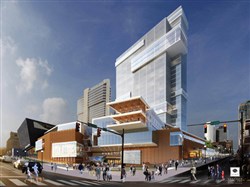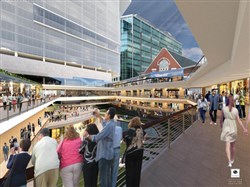VOL. 38 | NO. 4 | Friday, January 24, 2014
Redevelopers of Nashville's old convention center listen to market
By Joe Morris

Plans call for an 1,800-car garage to be dug under the site, 840,000 square feet of Class A office space, 52,600 square feet of museum space and 244,400 square feet of retail and entertainment.
-- Photo Courtesy Greshan Smith & PartnersEver since ground was broken on the Music City Center, the fate of its predecessor, the Nashville Convention Center, has been in flux. And settled. And in flux again.
Now, after a proposed medical mart fell through because a Dallas-based developer could never secure enough leases to advance financing and site redevelopment, a local outfit is stepping up to take a crack at the centrally located downtown site.
In December, the Metro Nashville Convention Center Authority tapped Spectrum|Emery Development to be master developer for the site.
By winning the bid, Spectrum|Emery bought themselves six months to finalize plans that include crafting a final development contract with the city, securing leasing for office and retail tenants, and firming up plans with the adjacent Renaissance Nashville Hotel and the proposed National Museum of African American Music, which would anchor the Lower Broad portion of the site.
Earlier this month, the Spectrum|Emery team, which includes Cushman & Wakefield|Cornerstone, rolled out some specifics for the site.
Plans call for a new, 1,800-car garage to be dug under the site, 52,600 square feet of space for the museum, 244,400 square feet of retail and entertainment space, a new conference center attached to the hotel and up to 840,000 square feet of Class A office space.
Cost estimates are in the $235 million range, with development in sections. If the schedule holds, the new museum and hotel conference center elements would open sometime in 2016.

Costs for convention center redevelopment are in the $235 million range, and development will take place in sections. The museum and hotel conference center are scheduled to open in 2016.
-- Photo Courtesy Of Gresham Smith & PartnersIn light of the medical mart’s failure to generate enough interest to move ahead, and the recent decision by HCA to abandon developer Alex Palmer’s West End Summit site in favor of a North Gulch property, the effort is seen by some as a gamble.
However, Spectrum-Emery President Pat Emery says the new plan has some angles that others didn’t, and those will be the game-changers that allow his team to succeed.
“Our plan would demolish the existing center, then go down two levels to get additional parking,” he says. “The parking really makes this project work, because by having those spaces underneath it we’ll see a higher demand for office [space], which already is in demand downtown, and it will also help the retail component.”
In addition to the development team, the Nashville Area Chamber of Commerce and Partnership 2020 will be working to help secure leases for all aspects of the property, he says, further enhancing its chances of success.
“Everyone is excited about how all the aspects of this development can play together, and the fact that it can be phased so that retail and parking are opening at one point, and then the office could come in at a later date if need be.”
From the convention authority’s perspective, the roadmap has all the components to succeed, plus the local team’s track record is an added bonus.
“Our evaluation committee had different thoughts for the site, but as we issued our request for proposals what it came down to was, ‘What is the highest and best use for the site?’ and how do we get that,” says Charles Starks, president and CEO of the authority.
“Is it residential? Is it office? Does it need another hotel? We kept hearing that office space is at a premium, and so that needed to be in, and they also incorporated the retail that we required by a part of any proposal, as well as the museum.
“But the layout they presented also had a good feel to it, including an intriguing way to work with the Renaissance to repurpose the space they currently lease from the city and make it a much better working arrangement for the hotel. Some proposals just left that meeting space intact, not really dressing that up at all, and this took the whole site and made it work better for the hotel.”
The team’s reputation should help it overcome the issues that held back earlier efforts, Starks predicts.
“This group understands how to develop projects and keep things moving from a sales standpoint, and I think they’ll get to critical mass,” he says. “The core business district is the city’s hottest market right now, which will help. Even HCA’s decision just put them closer into the downtown district. The medical mart was and is a viable concept, but it’s hard to compare this to that because it will be a very different venue.”
Downtown’s office-space market is also listed by Janet Miller, chief economic development officer for the Nashville Area Chamber of Commerce, as an arrow in the developer’s quiver. She, too, rebuts the idea that the high-profile Palmer-HCA deal collapse is a foretelling of the site’s continuing fate.
“I think what happened with HCA and Parallon [a subsidiary of HCA] isn’t an indication of the downtown market. If it had been, they wouldn’t have moved in closer,” Miller says. “I believe the Palmer site will be a great opportunity for the right company, at the right time.”
As to the convention center property, she says that it’s a highly desirable economic asset, and by making it multi-use the developers are likely to draw in people who would not have looked at the medical mart or any other type of single-use property.
“We are seeing unprecedented interest from prospects when it comes to office space in downtown Nashville, and that’s from people already here and those looking to relocate here,” she says.
“Quite honestly, the biggest limitation we face right now is that there is not enough ready-to-go office space here, and in Middle Tennessee, to meet demand. If a large user comes in, such as UBS with 1,000 jobs, Aramark with more than 1,000 jobs and Asurion with several hundred new jobs, they don’t have the luxury of waiting for buildings to be constructed.
“We have very limited choice when it comes to large blocks of office space, and that’s why from an economic development standpoint every square foot that can come out of the ground now can’t hit the market soon enough.”